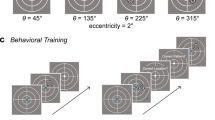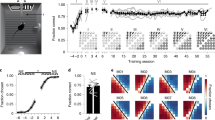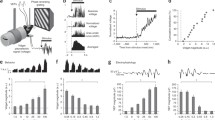Abstract
Recordings of the activity of 2705 single neurones were made in entorhinal and perirhinal cortex, area TG of the temporal lobe, and the inferior temporal cortex both during monkeys' performance of a serial recognition memory task using complex pictures and when monkeys were shown objects. Responses of 120 (9.7%) of the visually responsive neurones recorded were significantly smaller to the second than to the first presentations of unfamiliar stimuli. The incidence of such responses was highest in perirhinal cortex plus areas TE1 and TE2 of the temporal lobe, intermediate in lateral entorhinal cortex and areas TE3 and TG, and lowest in other parts of entorhinal and inferior temporal cortex. Response decrements were maintained across 20 or more intervening presentations of other stimuli for the majority of the neurones tested. Responses of 43 (14.4%) of the visually responsive neurones tested were significantly greater to unfamiliar than to highly familiar stimuli. Such differential responses were found only in lateral entorhinal and perirhinal cortex plus areas TG, TE1, TE2 and TE3. For 6 neurones the response difference was significant even when the familiar stimuli had not been seen for more than 24 h: such neurones demonstrate access to information stored in long-term memory for more than 24 h. Seven familiarity neurones signalled information concerning the relative familiarity of stimuli but not information concerning how recently they were last seen; 58 recency neurones signalled information concerning the recency of presentation of stimuli, but not their relative familiarity. Thus certain neurones demonstrate the separable encoding of recency and familiarity information. Neurones signalling information of use for recognition memory are found in cortex close to the rhinal sulcus where lesions result in major deficits in the performance of recognition memory tasks. The conjunction of these findings provides strong evidence for the importance of these neurones and this cortex for processes (recency and familiarity discrimination) necessary for recognition and working memory. The possible relation of the neuronal responses to priming memory is also discussed.
Similar content being viewed by others
References
Aggleton JP, Mishkin M (1983) Memory impairments following restricted medial thalamic lesions in monkeys. Exp Brain Res 52:199–209
Aggleton, JP, Passingham RE (1981) Stereotaxic surgery under x-ray guidance in the rhesus monkey, with special reference to the amygdala. Exp Brain Res 44:271–276
Aggleton, JP, Nicol RM, Huston AE, Fairbairn AF (1988) The performance of amnesic subjects on tests of experimental amnesia in animals: delayed matching to sample and concurrent learning. Neuropsychologia 26:272
Aigner TG, Mitchell SJ, Aggleton JP, DeLong MR, Struble RG, Price DL, Wenk GL, Mishkin M (1987) Effects of scopolamine and physostigmine on recognition memory in monkeys with ibotenic-acid lesions of the nucleus basalis of Meynert. Psycho pharmacology © Springer Verlag. 92:292–300
Baker RJ, Neider JA (1978) The GLIM (Generalised Linear Interactive Modelling) system. Royal Statistical Society (Numerical Algorithm Group, 7 Banbury Rd, Oxford)
Baylis GC, Rolls ET (1987) Responses of neurones in the inferior temporal cortex in short term and serial recognition memory tasks. Exp Brain Res 65:614–622
Baylis GC, Rolls ET, Leonard CM (1987) Functional subdivisions of the temporal lobe neocortex. J Neurosci 7:330–342
Bonin G von, Bailey P (1947) The neocortex of Macaca mulatta. University of Illinois Press, Urbana
Brown MW (1982) Effect of context on the responses of single units recorded from the hippocampal region of behaviourally trained monkeys. In: Ajmone-Marsan C, Matthies H, (eds), Neuronal plasticity and memory formation. (IBRO monograph series, vol 9) Raven, New York, pp 557–573
Brown MW (1990) Why does the cortex have a hippocampus? In: Gabriel M, Moore J (eds) Learning and computational neuroscience: foundations of adaptive networks. MIT, New York, pp 233–282
Brown J, Brown MW (1990) The effects of repeating a recognition test in lorazepam-induced amnesia: evidence for impaired contextual memory as a cause of amnesia. Q J Exp Psychol [B] 42A: 279–290
Brown MW, Leendertz JA (1979) A pulse-shape discriminator for action potentials. J Physiol (Lond) 298:17–18P
Brown MW, Wilson FAW, Riches IP (1987) Neuronal evidence that inferomedial temporal cortex is more important than hippocampus in certain processes underlying recognition memory. Brain Res 409:158–162
Brown MW, Brown J, Bowes JB (1989) Absence of priming coupled with substantially preserved recognition in lorazepam-induced amnesia. Q J Exp Psychol [B] 41A: 599–617
Fahy FL, Riches IP, Brown MW (1991) Neuronal evidence of the involvement of the primate medial thalamus in recognition memory. Eur J Neurosci [Suppl] 4:88
Fahy FL, Riches IP, Brown MW (1993) Neuronal signals of importance to the performance of visual recognition memory tasks: evidence from recordings of single neurones in the medial thalamus of primates. Prog Brain Res 95:401–416
Fuster JM, Jervey JP (1981) Inferotemporal neurons distinguish and retain behaviorally relevant features of visual stimuli. Science 212:952–955
Fuster JM, Uyeda AA (1971) Reactivity of limbic neurons of the monkey to appetitive and aversive signals. Electroencephalogr Clin Neurophysiol 30:281–293
Fuster JM, Bauer RH, Jervey JP (1981) Effects of cooling inferotemporal cortex on performance of visual memory tasks. Exp Neurol 71:398–409
Gaffan D (1974) Recognition impaired and association intact in the memory of monkeys after transection of the fornix. J Comp Physiol Psychol 80:1100–1109
Gaffan D (1992) Amnesia for complex naturalistic scenes and for objects following fornix transection in the rhesus monkey. Eur J Neurosci 4:381–388
Gaffan D, Murray EA (1992) Monkeys (Macaca fascicularis) with rhinal cortex ablations succeed in object discrimination learning despite 24-hour intertriai intervals and fail at matching to samle despite double sample presentations. Behav Neurosci 106:30–38
Heit G, Smith ME, Halgren E (1990) Neuronal activity in the human medial temporal lobe during recognition memory. Brain 113:1093–1112
Horel JA, Pytko-Joiner DE, Voytko M, Salsbury K (1987) The performance of visual tasks while segments of the inferotemporal cortex are suppressed by cold. Behav Brain Res 23:29–42
Insausti R, Amaral DG, Cowan WM (1987) The entorhinal cortex of the monkey. III. Subcortical afferents. J comp Neurol 261:396–408
Lindsey JK (1992) The analysis of stochastic processes using GLIM. Springer, Heidelberg New York Berlin
Mayes AR (1988) Human organic memory disorders. University Press, Cambridge
Mayes AR, Meudell PR, Pickering A (1985) Is organic amnesia caused by a selective deficit in remembering contextual information? Cortex 21:167–202
Miller EK, Gochin PM, Gross CG (1991a) Habituation-like decrease in the responses of neurons in inferior temporal cortex of the macaque. Vis Neurosci 7:357–362
Miller EK, Li L, Desimone R (1991b) A neuronal mechanism for working and recognition memory in inferior temporal cortex. Science 254:1377–1379
Mishkin M (1982) A memory system in the monkey. Philos Trans R Soc Lond [Biol] 298:85–95
Miyashita Y (1988) Neuronal correlate of visual associative longterm memory in the primate temporal cortex. Nature 335:817–820
Murray EA (1991) Medial temporal lobe structures contributing to recognition memory: the amygdaloid complex versus the rhinal cortex. In: Aggleton JP (eds) The amygdala: neurobiological aspects of emotion, memory and mental dysfunction. Wiley-Liss, New York, pp 453–470
Nishijo H, Ono T, Nishino H (1988) Single neuron responses in amygdala of alert monkey during complex sensory stimulation with affective significance. J Neurosci 8:3570–3583
Olton DS, Becker JT, Handelmann GE (1979) Hippocampus, space and memory. Behav Brain Sci 2:313–322
Parkin AJ (1987) Memory and amnesia: an introduction, Blackwell, Oxford
Pearson RCA, Esiri MM, Hiorns RW, Wilcock GK, Powell TPS (1985) Anatomical correlates of the distribution of the pathological changes in the neocortex in Alzheimer's disease. Proc Natl Acad Sci USA 82:4531–4534
Riches IP, Brown MW, Wilson FAW (1990) Neurones of inferomedial temporal cortex display evidence of memory for the previous occurrence of visual stimuli. Perception 19:269–270
Riches IP, Fahy FL, Brown MW (1991a) Involvement of the primate medial temporal lobe in recognition memory: neuronal evidence of long-term retention and discrimination of familiarity and recency. Eur J Neurosci [Suppl] 4:89
Riches IP, Wilson FAW, Brown MW (1991b) The effects of visual stimulation and memory on neurons of the hippocampal formation and the neighboring parahippocampal gyrus and inferior temporal cortex of the primate. J Neurosci 11:1763–1779
Rolls ET, Perrett DI, Caan AW, Wilson FAW (1982) Neuronal responses related to visual recognition. Brain 105:611–646
Rolls ET, Miyashita Y, Cahusac PMB, Kesner RP, Niki H, Feigenbaum JD, Bach L (1989) Hippocampal neurons in the monkey with activity related to the place in which a stimulus is shown. J Neurosci 9:1835–1845
Seltzer B, Pandya DN (1978) Afferent cortical connections and architectonics of the superior temporal sulcus and surrounding cortex in the rhesus monkey. Brain Res 149:1–24
Shimamura AP (1986) Priming effects in amnesia: evidence for a dissociable memory function. Q J Exp Psychol [B] 38A:619–644
Squire LR (1987) Memory and brain. Oxford University Press, New York
Squire LR, Zola-Morgan S (1991) The medial temporal lobe memory system. Science 253:1380–1386
Squire LR, Zola-Morgan S, Chen KS (1988) Human amnesia and animal models of amnesia: performance of amnesic patients on tests designed for the monkey. Behav Neurosci 102:210–221
Tulving E, Schacter DL (1990) Priming and human memory systems Science 247:301–306
Van Hoesen GW, Hyman BT (1990) Hippocampal formation anatomy and the patterns of pathology in Alzheimer's disease. Prog Brain Res 83:445–457
Van Hoesen GW, Pandya DN (1975) Some connections of the entorhinal (area 28) and perirhinal (area 35) cortices of the rhesus monkey. 1. Temporal lobe afferents. Brain Res 95:1–24
Weiskrantz L (1990) Problems of learning and memory one or multiple memory systems. Philos Trans R Soc Lond [Biol] 329:99–108
Wilson FAW, Rolls ET (1990) Neuronal responses related to the novelty and familiarity of visual stimuli in the substantia innominata, diagonal band of Broca and periventricular region of the primate basal forebrain. Exp Brain Res 80:104–120
Wilson FAW, Rolls ET (1993) The effects of stimulus novelty and familiarity on neuronal activity in the amygdala of monkeys performing recognition memory tasks. Exp Brain Res 93:367–382
Zola-Morgan S, Squire LR (1985a) Medial temporal lesions in monkeys impair memory on a variety of tasks sensitive to human amnesia. Behav Neurosci 99:22–34
Zola-Morgan S, Squire LR (1985b) Amnesia in monkeys after lesions of the mediodorsal nucleus of the thalamus. Ann Neurol 17:558–564
Zola-Morgan S, Squire LR, Amaral DG, Suzuki WA (1989) Lesions of perirhinal and parahippocampal cortex that spare the amygdala and hippocampal formation produce severe memory impairment. J Neurosci 9:4355–4370
Author information
Authors and Affiliations
Rights and permissions
About this article
Cite this article
Fahy, F.L., Riches, I.P. & Brown, M.W. Neuronal activity related to visual recognition memory: long-term memory and the encoding of recency and familiarity information in the primate anterior and medial inferior temporal and rhinal cortex. Exp Brain Res 96, 457–472 (1993). https://doi.org/10.1007/BF00234113
Received:
Accepted:
Issue Date:
DOI: https://doi.org/10.1007/BF00234113




